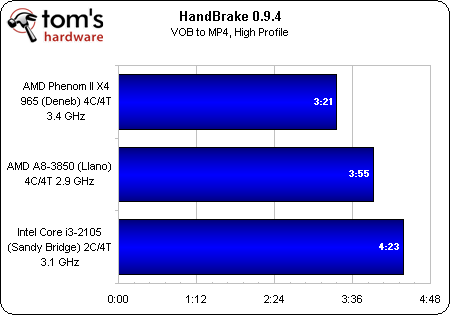AMD A8-3850 Review: Llano Rocks Entry-Level Desktops
Earlier this month we previewed AMD's Llano architecture in a notebook environment. Now we have the desktop version with a 100 W TDP. How much additional performance can the company procure with a loftier thermal ceiling and higher clocks?
Benchmark Results: Media Encoding
This one’s always easy to predict ahead of time. iTunes is a simple single-threaded app that scales similar to WinZip and Lame. That means the IPC-oriented improvements Intel made to Sandy Bridge (versus Nehalem) translate into big gains, while quad-core computing ends up meaning very little. The 3.4 GHz Phenom II X4 naturally finishes ahead of the 2.9 GHz A8-3850, then.
MainConcept is another story entirely. Well-optimized to exploit threading, the fast Phenom II clenches a first-place finish, and AMD’s 2.9 GHz A8-3850 falls into second place. The dual-core Core i3-2105 cannot keep up, and it takes a last-place spot.
The same holds true in HandBrake, and indeed you’ll find that, on average, most media-oriented applications that rely on processor performance favor cores over clock rate. The Phenom II X4 takes first place again, and A8-3850 comes in second. The Core i3’s two cores with Hyper-Threading take last for the second time in a row.
Ah, but we love mixing things up. Both MainConcept and HandBrake center on software-based encoders. They’re both limited to the performance of your processor. But Intel and AMD uniquely support hardware-accelerated transcoding features, too. Core i3’s HD Graphics 3000 engine includes Quick Sync, while A8-3850 includes UVD 3-based decoding acceleration and encode acceleration through the GPU’s 400 ALUs.
I’ve received emails questioning the use of Quick Sync as cheating in favor of Intel, since it employs a black box of sorts to alter the output quality. That's actually an interesting angle to explore. The fact of the matter is that any time you use hardware acceleration, including AMD’s, to parallelize a transcoding workload, the output file is going to deviate from the source. If you want to explore the implications of utilizing hardware to speed up your transcodes, check out Video Transcoding Examined: AMD, Intel, And Nvidia In-Depth, where we go into depth on this very issue. If quality is your main concern, disable acceleration features altogether and stick with software.
CyberLink’s MediaEspresso 6.5 not only allows us to test software-only, but it also supports Intel’s and AMD’s respective hardware-based capabilities.
Amazingly, Quick Sync is the only technology worth using. MediaEspresso correctly defaults to software mode when we fire up the 890GX and Llano-based configurations for the first time, as the benefit to using hardware-based decode and encode is minimal.
Get Tom's Hardware's best news and in-depth reviews, straight to your inbox.
Higher-end discrete cards with more general-purpose compute power might fare better, but these lightweight integrated engines simply don’t have the displacement to drag race against Intel’s fixed-function implementation.
Current page: Benchmark Results: Media Encoding
Prev Page Benchmark Results: Productivity Next Page Power Consumption-
SteelCity1981 So then what's the point of getting the Turbo Core versions when they are going to be Turbo Clocked slower then the none Turbo Clocked versions...Reply -
cangelini SteelCity1981So then what's the point of getting the Turbo Core versions when they are going to be Turbo Clocked slower then the none Turbo Clocked versions...Reply
They don't want you to see better performance from a cheaper APU in single-threaded apps by pushing Turbo Core further ;-) -
Known2Bone i really wanted see some amazing gains in the content creation department what with all that gpu power on chip... oh well games are fun too!Reply -
ivan_chess I think this would be good for a young kid's PC. It would be enough to run educational software and a web browser. When he grows up to be a gamer it would be time to replace the whole machine anyway.Reply -
DjEaZy ... it's may be not the greatest APU for desktop... but it will be a powerful thingy in a laptop... the review was nice... but in the gaming department... would be nice to see a standard 15,x'' laptop resolution tests @ 1366x768... or something like that...Reply -
Mathos Actually if you want good DDR3 1600 with aggressive timings, the Ripjaws X series memory that I have does DDR3 1600 at 7-8-7-24 at 1.5v, not all that expensive when it comes down to it either.Reply -
Stardude82 This makes little sense. An Athlon II X3 445 ($75) and a HD 5570 ($60, on a good day you can get a 5670 for the same price) would provide better performance for the same price ($135) and not have to worry about the RAM you use.Reply
So is AM3+ going to be retired in favor of FM1 in the near future? Why are there chipset at all? Why isn't everything SOC by now?
Otherwise this is a very good CPU. If AMD has used 1 MB level 2 caches in their quads when they came out with the Deneb Propus die, they would be much more competitive. -
crisan_tiberiu stardude82This makes little sense. An Athlon II X3 445 ($75) and a HD 5570 ($60, on a good day you can get a 5670 for the same price) would provide better performance for the same price ($135) and not have to worry about the RAM you use. what about power consumption?Reply




